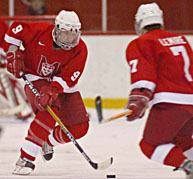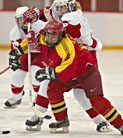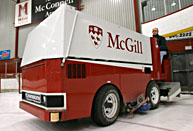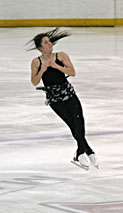Cool times at the McConnell Arena
Cool times at the McConnell Arena McGill University
User Tools (skip):
Cool times at the McConnell Arena
A wise man once said there are only two things a man can just stare at and be perfectly content: a fireplace, and a Zamboni.
A fire, of course, can more or less look after itself, but who spares a thought for the Zamboni driver? It can't be easy handling a three-tonne vehicle on a pure ice surface.

Action on ice
Andrew Dobrowolskyj
Those interested in the Zamboni driver's art need only go to the McConnell Winter Arena, home of the Redmen and Martlet hockey squads — not to mention anything else that happens on ice at McGill, from figure skating to free skates.
The Zamboni is key to maintaining the fresh, smooth ice required for a good game of shinny. From the perspective of a spectator, the job looks simple enough — drive around in circles, park, repeat after every period.
In fact, there's much more to it than that. At approximately three-quarters of a mile per resurfacing, if there are four resurfacings per game, the machines travel an average of three miles during each hockey game. That doesn't even count the hundreds of other resurfacings that are done for the myriad other users of the rink.
Joe Carrado is one of the four groundskeepers who provide ice maintenance at the McConnell. He says that ice maintenance isn't something you can just hop on the machine and do — there is an art.
"This is my fifth year doing it and I only now think I have a real feel for it," he said.
Keeping the ice smooth is a complex blend of factors. The outside temperature has a very real effect on the temperature of the uninsulated arena, as any McGill hockey fan knows.
The ice itself is only about three-quarters of an inch thick, and the jumps, starts and stops of daily use can easily gouge the surface right down the concrete.
"The faster you go, the less water, and the slower you go the more water is put on the ice," said Carrado. "You can go around in about six minutes, but you should take 12 to 15."

The Martlets in a demo game with China's national women's hockey team on November 26. China won 6-0.
Andrew Dobrowolskyj
Carrado explained that knowing how much "knife" to give is important too. This is essentially a 77-inch razor blade (replaced once a week) that shaves the uppermost surface of ice. The more knife, the smoother the ice and the less water needed, but more ice is removed from the already thin surface.
"You really need to have a feel for it," he said.
It's not all so intense — Carrado reluctantly confessed that the Zamboni drivers have been known to have fun on the ice with the giant vehicle, pulling some wicked doughnuts on the slick surface.
Even as Carrado explains his craft, a single figure skater is practicing to a Sarah McLaughlan tune, her CD player patched through the arena's sound system. Although her graceful spins and leaps look as if she is barely scratching the surface, Carrado said the otherwise smooth ice will need to be given a run-over by the machine before the Martlet hockey squad gets in the rink for their daily practice.
At one point Rebecca Grant might have been that figure skater. The pharmacology PhD student has been an avid skater since her youth, when she grew up within walking distance of the local rink. Then it was for fun; now it's for sanity.
"Without something like skating, winter would be a never-ending story. In order to survive the winters here we have to enjoy the snow and enjoy the cold weather," said Grant.
She used to take figure skating lessons through McGill on the weekend, but lately skates strictly for fun.

Steve Larin keeping the ice smooth with McGill's three-tonne Zamboni
Andrew Dobrowolskyj
"I kept my skates in my locker in the lab. I'd run out to the rink, skate around for an hour and then come back to the lab feeling completely rejuvenated," she said.
Peter Smith is the Martlet's coach and athletics facilities manager. He said that the venerable McConnell — built in 1956 —recently underwent a $4 million renovation.
"We gutted the building — we re-did the stands and put in the alumni lounge," he said. This was in addition to work that had been done a few years earlier to refit the arena's refrigeration system. More work will be done in the coming years to replace the boards around the ice surface and adding a dehumidification system to counteract the occasional fog that clouds the arena.
Behind the bleachers of the hockey rink lie the offices, locker rooms and other facilities required for arena operations. When I met Smith he was reviewing game tapes in his windowless office.
The McConnell will be able to show off its facelift to the country when it hosts the CIS Women's hockey championships this March. As the host, McGill's team gets a bye into the tournament. I asked Smith if this has any effect on keeping the team motivated.
"It changes things — your approach is one of development. You really want to be playing your top hockey by that time of the year," he said.
Smith has been coaching women's hockey for 13 years, five with the Martlets. In addition to the 16 league games the team plays in a season — not counting play-offs and demonstration games, such as a recent one against the Chinese team — the women practice about an hour and a half every weekday.
Just off the comfortable alumni lounge at the south end of the arena is a classroom-like space with a mini-fridge in the back and a giant TV in the front. Here Smith and his players will review game tapes to fine-tune strategy and work on problem areas using video edited by athletics staff.

Kinesiology student Mona Hoy takes a twirl
Andrew Dobrowolskyj
Afterwards the team will head back to their locker room, which comes equipped with showers and exercise bikes for the team to warm up on (the visitors room lacks the bikes — I pointed out that this isn't quite sporting, but Smith assured me they usually bring their own equipment).
Just down the hall from the locker room is a physiotherapy clinic, which also contains first aid equipment and a stretcher for removing injured players from the ice. Smith said both varsity teams have their own doctor, but thankfully there have been few injuries this year.
Of course, the varsity teams aren't the only players that use the ice. Intramural teams, noon-hour shinny and beer-league teams who rent the arena all use the facility. For the intramural games, athletics has 100 sets of hockey equipment from socks to jocks that you can access with a $30 equipment card.
James Hodson is the equipment go-to guy for the intramural program. Keeping inventory, making sure equipment isn't damaged and keeping things clean are part of his many responsibilities. His cavern of hockey treasure is stuffed to the gills with helmets, jerseys and pants: "The only thing we don't supply are skates and sticks," he said.
It reeks of disinfectant.
"Everything is cleaned at least twice a week — some things three times a week," he said "Jerseys smell after just one use, but I can't clean them after every game."
Hodson is more than just an equipment manager, however. He is often called upon to issue edicts that would baffle Solomon.
Hodson only has four colours available for jerseys. Conflict often arises amongst intramural teams regarding uniform hue: If you've won the last four games wearing teal, you're not want to going to be assigned grey. If your team name is Lenin's Linesmen, you might be partial to red. Often teams will want the same colour — what does Hodson do?
"I'll tell 'em to flip a coin, and say next time the other guy gets it," he said.
Not all of his justice is so easy to dispense. If a team has brought their own jerseys, he isn't going to make them change to avoid having two blue teams on the ice.
It's quite a challenge to keep it all straight. There are 66 intramural teams, including five women's teams. Each team plays 12 games a season, starting at the end of September.
Each of these games requires a referee, and the chief zebra for intramural games is Andrew Howard. Howard and the other students who sign up to become refs are paid for their time and expertise (many are Canadian Hockey Association certified).
It's a tough job. In addition to the taunts and arguments refs constantly face on the ice, there are physical dangers as well.
"We had a one ref who was knocked unconscious this season — he fell over backwards and landed awkwardly," said Howard.
More likely is being hit by an errant puck: "Those things really hurt, especially if it's really cold."
For the most part, there aren't too many intense situations on the ice a ref needs to worry about, and those that occur can be laughed about later.
"Sometimes you have to break-up small fights, but in the intramural games often they don't know how to fight on their skates and they're falling all over the place," said Howard.
Squads are made up of students from faculties, residences, fraternities or "free agents" for those who want to play but don't have a way to make their own team. There are four men's divisions, ranging from "A," which is for the most advanced players, to "D," which is for absolute beginners. A, B and C leagues play for the McGill Mug — a glass beer stein.
Perry Karnofsky, assistant manager of campus recreation, said that teams usually decide which league they belong in, but he has had to shuffle leagues on occasion.
"If we find that a team is really getting kicked or really kicking a lot of teams unfairly we reserve the right to move teams around," said Karnofsky.
"In our advanced teams we'll have some people that have played some pretty competitive hockey in their youth — we even have some former Redmen and alumni," he said.
The D league is a different matter.
"McGill has a big foreign student contingent, so the idea of the D league is to give these kids a chance to experience hockey. We have a lot of participants who are barely standing up on their skates, but they're having some fun, and that's what it's about."
